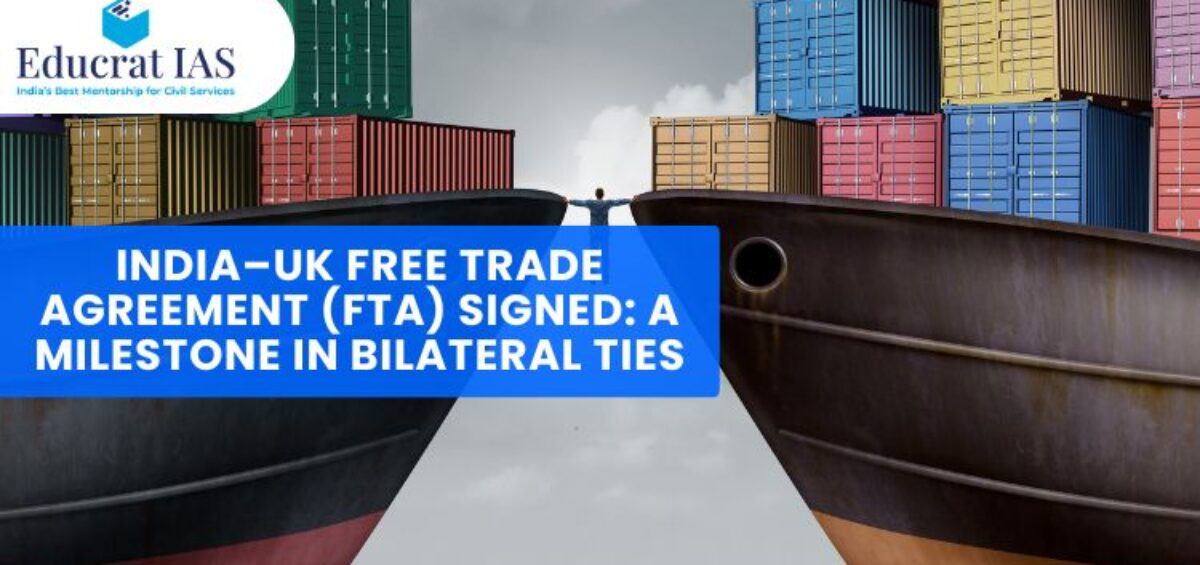In a historic move aimed at deepening economic cooperation, India and the United Kingdom signed a landmark Free Trade Agreement (FTA) on 24 July 2025. After nearly 14 exhaustive rounds of negotiations starting from 13 January 2022, this deal is expected to transform trade dynamics, improve investment flow, and open new doors for students, professionals, and small businesses. For aspirants preparing for UPSC or any other civil services exam, this development is a must-know for Prelims, Mains GS2, GS3, and Essay.

🔗 Also Read: Daily Current Affairs for UPSC – Updated
Main Mission Objectives of India–UK FTA
- Boost Bilateral Trade: Enhance India-UK trade to USD 120 billion by 2030.
- Remove Trade Barriers: Gradual elimination of tariffs on 90% of traded goods.
- Create Job Opportunities: Expected to create over 1 million direct and indirect jobs across both nations.
- Ease Student Mobility: Simplify visa norms for Indian students pursuing education in the UK.
- Attract Investment: Improve foreign direct investment (FDI) flow from UK to India, especially in sectors like technology, infrastructure, and green energy.
- Support MSMEs: Facilitate market access and lower entry barriers for micro, small, and medium enterprises.
- Enhance Services Sector Collaboration: Especially in IT, fintech, legal services, and healthcare.
The 7 Key Importance of the India–UK FTA

- Trade Expansion: Eliminates tariffs on 90% of traded goods, increasing competitiveness and exports.
- Educational Exchange: UK agrees to simplify student visa regulations; opens dual-degree pathways.
- Legal Sector Reforms: UK-based firms can now collaborate with Indian legal firms in non-litigation domains.
- Tariff Relief in Textile Sector: Major advantage for India’s textile and garment exports to the UK.
- Technology Transfer: Promotes exchange of climate tech and AI-based innovation systems.
- Strategic Significance: Strengthens India’s presence in the European trade map post-Brexit.
- Geopolitical Signaling: Reinforces India’s role as a preferred trade partner in the Global South.
Impact on India (With Focus on Kolkata & Eastern India)
- Bengal’s Export Growth: Key exports like jute, leather, and marine products from Kolkata and Haldia ports to benefit.
- Skill Demand Surge: Growing demand for English-speaking professionals in legal, IT, and medical sectors.
- Student Opportunities: Increased scholarship tie-ups between British universities and institutions in Kolkata.
- Manufacturing Sector Boost: Bengal’s small manufacturing units, especially textiles, likely to see export hikes.
- Job Market Push: UK-based companies setting up skill training and IT parks in Eastern India.
📌 For local context, this deal is expected to increase Kolkata’s export volume by 30% over the next five years.
Why is the India–UK FTA So Significant Now?
- First Major FTA with a Western Power Post-Brexit
- Aligns with Atmanirbhar Bharat and Make in India policies
- Diversifies India’s trade basket beyond traditional Asian partners
- Strengthens India’s position in Indo-Pacific Economic Framework
- Enhances India’s bargaining power in other ongoing trade talks (EU, Canada, etc.)
Past Reference – Evolution of India–UK Trade
- 1993: First Indo-UK Joint Economic and Trade Committee (JETCO) established
- 2021: Comprehensive Strategic Partnership signed
- 13 January 2022: FTA negotiations officially launched
- 6 May 2025: Agreement in principle reached
- 22 July 2025: Cabinet approval granted by Government of India
- 24 July 2025: Formal signing of the FTA in London, at Chequers, the British PM’s official residence
- October 2025: Expected phased implementation begins
Conclusion

The India–UK Free Trade Agreement 2025 is more than just a trade pact; it is a strategic blueprint for economic growth, innovation, and cultural exchange. With job creation, academic mobility, FDI influx, and tariff reduction at its core, the FTA will likely be a game-changer for both nations.
For UPSC aspirants, it’s a case study in international diplomacy, trade policy, and bilateral relations—tailored perfectly for GS2 and GS3 papers.
💡 Stay Updated: Check our Daily Current Affairs Section
📞 Let’s make it easier… Dial Now +91 9163228921 or Contact Us for expert mentorship.
FAQs: (India–UK FTA for UPSC & Awareness)
Q1. When was the India–UK FTA officially signed? A: On 24 July 2025 at Chequers, UK.
Q2. What sectors benefit most from the FTA? A: Textiles, education, technology, legal services, and MSMEs.
Q3. What is the trade target set under the India–UK FTA? A: USD 120 billion in bilateral trade by 2030.
Q4. How will this affect students from Kolkata? A: Eased visa rules, higher scholarships, and UK-based campus placement tie-ups.
Q5. Is this India’s first FTA with a Western country? A: Yes, it is the first post-Brexit FTA signed with a major Western economy.
Follow us on our social media channels for the latest updates:
Telegram : Join our Telegram community for daily current affairs, free PDFs, and important UPSC updates.
Instagram: Follow us on Instagram for quick tips, answer writing guidance, reels, and motivational posts.
Facebok: Like our page to stay connected with webinars, UPSC trends, and student success stories.
X : Follow us for crisp analysis of editorial opinions, government policies, and international affairs.
Call us now at +91 9163228921 or visit educratias.com to start your UPSC journey with Kolkata’s most trusted institute!
Don’t just scroll—engage, learn, and transform your preparation with Educrat IAS!






